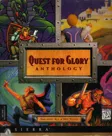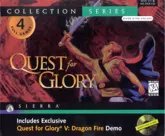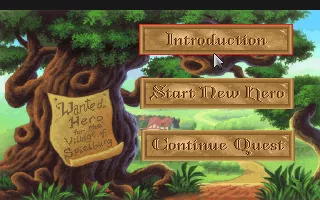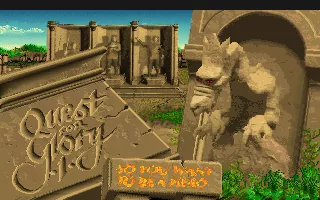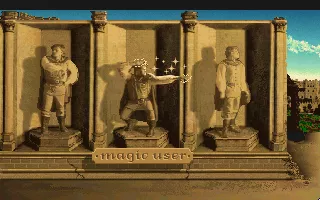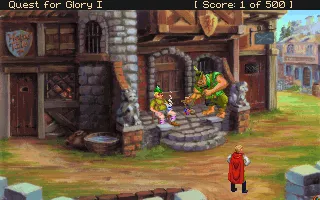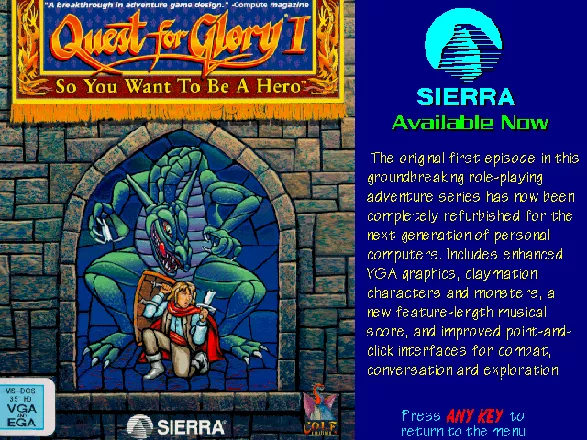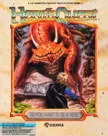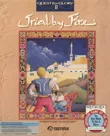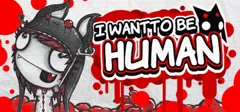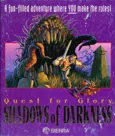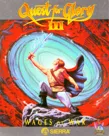Quest for Glory I: So You Want To Be A Hero
Description official description
Quest for Glory I: So You Want To Be A Hero is a remake of Hero's Quest: So You Want To Be A Hero.
The remake features 256-color VGA graphics. Locations have been re-drawn, and character portraits appear during conversations. This version also has an icon-based interface instead of the text input of the original, very similar to the one used by Sierra for their adventure titles. The player selects dialogue choices from a dialogue menu, as opposed to typing in conversation topics in the earlier release. A few changes have been made to the dialogue, adding (or altering) some of the easter eggs and references to other games.
Combat now features clay models for the enemies and stop-motion animation. The perspective has been switched to an over-the-shoulder view farther away from the player. Battle commands (two types of attacks, parry, and dodge) are displayed as icons on a shield in the corner of the screen. The player can switch to the spell menu at any time, and also click the middle of the screen to escape from combat.
Spellings
- 영웅의 길 I: 당신도 영웅이 되고 싶은가 - Korean spelling
Groups +
Screenshots
Promos
Videos
Add Trailer or Gameplay Video +1 point
See any errors or missing info for this game?
You can submit a correction, contribute trivia, add to a game group, add a related site or alternate title.
Credits (DOS version)
31 People · View all
| Executive Producer | |
| Creative Director | |
| Producer | |
| Director | |
| Game Designers | |
| Art Designer | |
| Lead Programmers | |
| Composer | |
| Incredible Artwork | |
| Original Music | |
| Bugbusters | |
| [ full credits ] | |
Reviews
Critics
Average score: 82% (based on 9 ratings)
Players
Average score: 4.1 out of 5 (based on 52 ratings with 8 reviews)
The Good
It looks like an adventure, it feels like an adventure, and to a certain extent it also plays like an adventure - but there is more. Created by Lori Ann Cole and her husband, Quest for Glory was conceived at a time when Sierra had supreme dominance in the genre. Its several "quest" series were flourishing, and the company was at one of the peaks of its creative power. The designers took everything that made Sierra adventures work and expanded it by masterfully injecting the familiar formula with delightfully fulfilling light role-playing elements.
Even as a pure adventure, the game would still work. The high interactivity level allows performing any action on any available object, and more often than not you'll get an interesting or funny remark. Try taking women, talking to walls, pushing houses. Those were the days: you weren't restricted to a stupid cursor that figured out all the actions for you, and the interactivity wasn't limited to a couple of carefully highlighted objects sticking out of the backgrounds. The puzzles are not too taxing, but there are a few tricky tasks that require actual thinking on your part - not in the least because the RPG element adds another layer to puzzle-solving.
Indeed, Quest for Glory treats role-playing in its own original way, strengthening and deepening pure adventure gameplay. There is no excessive dungeon crawling, frustrating unbeatable enemies, overdoses of mechanical repetition, or high mathematical equations to solve in order to build the optimal party. The adventure core remains intact - you are acting solo, and individually designed locations with developed characters have precedence. And yet, RPG traits are an inseparable part of the game's structure, brilliantly integrated into adventuring gameplay.
There is a standard choice of classes in the beginning: Fighter, Thief, or Mage. Unlike most pure RPGs, where these choices may greatly affect combat but leave the actual game progression intact, in Quest for Glory those classes are treated as yet another variable pertaining to the solution of the game. In other words, many tasks and events will be quite different depending on the class you choose. The puzzles will offer alternate solutions, you'll have to meet other people, visit other locations, pick other items, etc. Not to mention the standard class gameplay differences that are also quite fun - spend the game as a brute who knows nothing but wielding a sword, as a cunning, stealthy lock-picking fellow, or as a powerful magician that unleashes his wrath on innocent goblins and ogres.
The RPG system is an example of greatness disguised as simplicity: your hero has attributes mixed with skills, such as strength, stamina, throwing, climbing, honor, etc. This pretty much sums it up - and it's extremely fun and rewarding to increase those stats and make your hero to what you want him to be. Everything you do in the game world affects your skills. Practice tree-climbing and you'll see that in the end of the game you'll be able to climb over a wall. Work out a lot and tackle obstacles the most direct way if you are tired of thinking. No need to wait for levels and count experience points - there you are, you are doing something, and effects are immediate: practice makes perfect. Meet a robber and throw a stone at him - if you are good at throwing, you'll nail him down, if not... maybe there is another way? This is the kind of role-playing you'll enjoy in this game.
The combat is simple and effective. Attack and parry - this is all you need to know, if you are a fighter. As a mage, there is of course a variety of spells to cast on your foes. The more you use a certain type of magic, the better magician you become; the more you fight, the stronger you get; the more you get hurt, the higher is your stamina, etc. Combat doesn't depend only on your manual dexterity. A weak fighter cannot handle the ogre who protects the way to his cave. You'll have to train or fight more in order to be able to defeat that brute. Or look for sneakier solutions as a thief if that is your preferred style of playing.
The world of Quest for Glory is lively and atmospheric. There is a day and night cycle and internal clock, like in Ultima games. You'll make appointments, and they will actually mean something - you'll have to check out the game's time and be not only in the right place, but also at the right moment. You feel how Spielburg really lives its life, how things change depending on the time of the day. The surrounding forest is reasonably large but not maze-like, with interesting places to discover - and there is little that restricts your exploration.
And of course, there is plenty of Sierra's typically mild and sweet humor. There is a little bit of everything - silly or sophisticated puns, ironic attitude to the main character ("overworked, underpaid, no direction in life", according to the hero himself), hilarious death scenes, cameo appearances and references to other games ("I want to be a pirate!"), and so on. The characters are talkative and appealing. There is a lot of dialogue in the game, a lot of stuff to ask about, things to buy, enemies to encounter, quests to take, etc.
In the early 90-ies, Sierra published a series of remakes of their classic "quest" titles featured wonderful hand-drawn 256-color VGA graphics and a comfortable icon-based interface (instead of the old text input). This is one of those updated versions. Gone are the 16-color world and the tiresome text interface. The necessity of an updated interface is more evident here than in other Sierra remakes. Quest for Glory has an extended dialogue system: you must talk to people you encounter about various topics in order to gain important information. In the original, you had to think of and type the conversation topics all by yourself. That was interesting, yet at times frustrating. In the remake the conversations topics are all presented in a nice dialogue menu. And of course, manipulating action icons and clicking on stuff is much more comfortable than typing commands.
The graphics also got a tremendous boost in the remake. Quest for Glory undeniably belongs to the most beautiful games of early nineties. The characters and the backgrounds, with their claymation-like look, are simply fabulous. The magical atmosphere of a fairy-tale world envelops the player completely (check out, for example, Erana's Peace location, or the road to the castle). The graphics haven't lost their appeal, and don't seem outdated to this day.
The Bad
The ever-present "Sierra Dead End Syndrome" (TM) is still here. You do something that doesn't lead to an immediate death, peacefully continue the game, and later (sometimes much later) discover, to your horror, that the damage you have done is irreversible and you must restore a saved file from earlier (sometimes much earlier). That happened to me, for example, with the reagent lady, from whom I carelessly stole something and who caught me while I was doing the evil deed. Later, she wouldn't give me a plot item without which it was impossible to finish the game. Of course it is good that the game punishes needless stealing from innocent ladies, but I wish the punishment would come sooner.
Quest for Glory is a bit too short. You can fool around with things and there is room for exploration; but once you are set to go through the tasks that take you to the end of the game, you'll discover there isn't a whole lot required from you. There are several characters you can meet and chat with, but few are truly memorable. Later installments of the series would have more elaborate plots and feature more interesting characters - but we mustn't forget that the foundation stone was laid here.
The VGA remake, like many of its contemporaries, has a few bugs and very annoying game-breaking speed issues that can sometimes only be resolved by disabling internal cache in your computer's BIOS - or playing the game on a machine of roughly the same speed it was programmed for when it first came out.
The Bottom Line
Quest for Glory gives us everything there is to love in Sierra adventures: generous interactivity, well-written text, reasonable challenge, and endearing humor. On top of that, it adds an elegantly designed light role-playing system graciously complementing and enhancing pure adventure gameplay like never before or after. Savor it and its sequels, because games like this are not being made anymore.
DOS · by Unicorn Lynx (181780) · 2015
Almost completely superior... almost
The Good
What's there not to like about the game? The hand painted graphics still hold up almost two decades after the game's original release, the claymation monsters and models would never really get old, and the overall story would be best dubbed a classic.
Compared to the EGA version, the land of Spielburg (contrary to popular myth, is not named after Steven Spielburg, but is a pun: Spielburg means 'game town' in German), is much more alive and easier to explore, with the added benefit of a few new easter eggs (such as finding Earl Sinclair from Dinosaurs) that were more from the early 90's than the late 80's. the level of detail and quality of the artwork is better than the original as well. This wasn't surprising, since Quest for Glory was the last major 'quest' series to be launched by Sierra (though not the very last, EcoQuest held that title, but it wasn't nearly as big as any of the rest), and when they got about to making the remakes, it was the very last game to be remade. For that, I'm wiling to assume that the artists had had enough experience with graphic design to make this game the best looking of the original EGA and VGA remakes.
The interface was also quite good, with the icons looking better than most early sierra VGA games actually. What really was improved dramatically I believe I was the combat. Beyond better graphics, I believe that the game play, while not perfect (The series was never that good on combat mechanics), was much better than the original EGA, which for the life of me, I never quite got. Also the tie-ins from other QFG games and sierra series never fail to put a smile on my face. The dialogue trees were also some of the best in the entire series, if overtly simplistic (but that could be excused by the fact that they are not tied to any in-game event, and as such are available in their entirety from the start). And in my own opinion, the inventory interface is still the best in the series.
The Bad
(Please note that these might contain some spoilers. You have been warned)
I mentioned in my title that I called it 'almost' completely superior. Are there problems? Yes there are, and sadly, many of them are so glaring that they seriously detract from the game play and immersion.
Firstly, in the bad old days of pre-DosBox, there was the Sword Master problem... in the game, as a fighter, you had to beat the sword master to get full points, and since the game ran on it's own clock, if you manage to get the game running without dosbox, it meant that he would move at lightening speed and defeat you before you were able to press the first attack button. Though this has been solved by DosBox, it still annoyed me for years on end before then, and I still resent it quite greatly (while other games had clock issues, none of them had problems of this magnitude).
The other big problems were the potions and goblins 'training' looting bugs. When buying potions of the from the healer, you had to open and close your inventory twice after every purchase to make sure you got it. What I mean is, if you buy two stamina potions in a row, but don't check your invention after every purchase, you will only end up with one potion. Same thing applies to looting the dead goblins you fight in the goblin training grounds screen. If you search one and don't double check your invention, you will only get the money from the latest one you searched. Though this isn't a gamebreaker, this issue makes it rather tedious to perform what is a routine game function.
Another bug (again solved by DosBox, but still annoying) is that Yorick does not leave the maze room even after you explain your purpose there, and unless you adjust the game cycles he would continue to throw things at you to hinder your progress through the maze. In the original game, after telling him/ why you were there, he would leave you alone. It was another notable error.
The graphics issue that almost everyone has experienced... well I suppose I could give it a notable mention, but to be honest I was never bothered by it as a kid, and as an adult, I just like to think it's the effect of the mushrooms that the hero would use to get his mind of the fact that every monster in the forest wants him dead.
But to me, the single biggest problem in the entire game is the dagger bug. In every iteration of QFG, before combat, you could throw daggers at your enemy, and then after combat you could pick them up. This includes QFG EGA, but in the VGA remake, if you throw a dagger at your enemy and then enter combat, that dagger is gone forever. You could avert it by throwing a dagger and then picking it up before combat, but that still does not excuse the original issue.
The Bottom Line
Have you ever wished you could leave the world and all it's problem and embark on a great adventure? Well this is it, and it gives a brilliant and colorful start to a great series of adventure games.
That being said, the game really was an overall great improvement and if it wasn't for the annoying bugs, it would have been a 100% improvement over the original in every way.
DOS · by Salim Farhat (69) · 2011
The start of an great adventure series
The Good
A remake of the original Quest for Glory, this game features improved graphics, a point and click interface, and easier combat. The storyline remains the same as the original game, and features one of Sierra's best musical scores, rivaling the King's Quest series. The character and world graphics are amazingly detailed for their time, and the land of Spielburg has a wide array of different environments to show them off. The point and click interface allows for easier interaction with objects in the world, the inventory menu, and dialogue options. Combat has been changed from keyboard commands to an action bar in the corner that allows you to click on your desired action, making it much easier for someone to just open up the game and start playing.
The Bad
Purists of the original game might find the new combat system a bit watered down from the original. Also, with the new engine came new problems. An occasional graphical glitch can occur for most users, causing the graphics to remain glitched until the user exits the game. Players may also find themselves not knowing what to do next in the game, due to some lack of instruction on where to go or what to do next.
The Bottom Line
The Quest for Glory series is an epic story that spans 5 games, and this is the one that started it all. It is a game that has wonderful storytelling, a diverse character ensemble, and quite a bit of humor that will want you playing the sequel immediately after beating it. If you have a few hours you can just sit down and spend with a game, I would highly recommend this title to any fan of fantasy or adventure games.
DOS · by Aaron Cole (7) · 2009
Trivia
Easter Eggs
- If you walk right, straight out of Spielburg, then back to the Spielburg gates a few times, you'll meet up with the father from the TV series Dinosaurs
- When you take a look at the lamp in the Kattas Tail Inn, it says "Lamp for rent. Inquire in Quest for Glory 2: Trial by Fire for information."
References
- Keep clicking the eye icon on the trees, because you'll eventually get one called a "Daventree". This is a reference to Daventry, the main setting of King's Quest.
- Every now and then when the Gargoyle above Erasmus's house asks "What is your Quest?" (obvious Monty Python joke) one of the answer choices is "I want to be a pirate!" This is, of course, a reference to The Secret of Monkey Island. If you select it, the Gargoyle says "Boy, have you got the wrong game," and sends you back down the mountain.
- When the gargoyle above Erasmus's house asks the name of the hero, one of the answer options is "Call me Ishmael." This is a reference to Moby Dick.
- The most common password to the thieves guild in the game is 'schwertfisch'. Schwertfisch is German for swordfish, which in turn is the password to a speakeasy in the Marx Brothers movie Horse Feathers.
- The town of Spielburg is, of course, named after Steven Spielberg. Sam the beggar also makes a reference to Amblin, which is Steven Spielberg's production company.
- In Erasmus' house there is a Sarcophagus tied in with a ribbon, called a Lara Bow (a reference to the character Laura Bow from The Colonel's Bequest and The Dagger of Amon Ra).
Information also contributed by Itay Shahar, Leofan93, OceansDaughter, Timo Takalo, and WizardX
Analytics
Upgrade to MobyPro to view research rankings!
Identifiers +
Contribute
Are you familiar with this game? Help document and preserve this entry in video game history! If your contribution is approved, you will earn points and be credited as a contributor.
Contributors to this Entry
Game added by Unicorn Lynx.
Macintosh added by Terok Nor.
Additional contributors: PsOmA, Alaka, Pseudo_Intellectual, lee jun ho, Trypticon.
Game added December 27, 2004. Last modified January 20, 2024.


